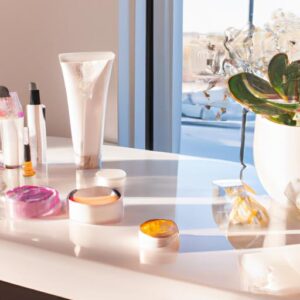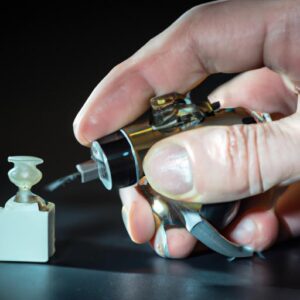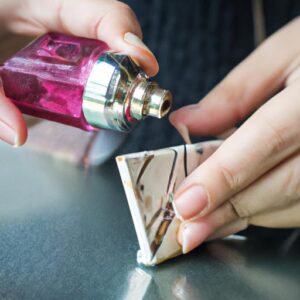Introduction
Have you ever experienced a skin reaction after applying a new perfume? Itchy red patches or even blisters can quickly ruin the joy of trying a new fragrance. That’s where patch testing comes in. In this article, I will guide you through the importance of patch testing perfume, explain what it entails, and highlight the benefits it offers.
Importance of Patch Testing Perfume
Before diving into the world of fragrances, it’s crucial to understand the significance of patch testing. Perfumes contain a wide range of ingredients, some of which can cause allergic reactions or irritate sensitive skin. By patch testing, you can identify potential adverse reactions before applying perfume all over your body, preventing discomfort and more severe consequences.
What is Patch Testing?
Patch testing involves applying a small amount of perfume to a specific area of your skin and observing any reactions that may occur over a designated period. This controlled test helps you determine if a particular fragrance is safe for your skin or if it triggers allergic reactions. By pinpointing the culprit, you can avoid future discomfort and enjoy perfumes that suit your body chemistry.
Benefits of Patch Testing
Patch testing offers numerous benefits, ensuring your well-being and helping you make informed choices when it comes to fragrance. By conducting a patch test, you can:
-
Identify allergies: Patch testing allows you to identify specific ingredients that may cause allergic reactions, such as redness, itching, or swelling. Armed with this knowledge, you can avoid perfumes containing those substances.
-
Protect sensitive skin: If you have sensitive skin, patch testing is even more crucial. It helps you determine which fragrances are gentle enough to avoid skin irritations or dermatitis.
-
Customize fragrance selection: Each of us has a unique body chemistry that interacts differently with perfumes. By patch testing, you can find the scents that harmonize with your skin, enhancing the fragrance’s longevity and ensuring it complements your natural scent.
Now that we understand the importance of patch testing perfume, let’s move on to the practical steps involved. In the next section, I will guide you through a step-by-step process to effectively patch test perfumes.
Why Patch Test Perfume?
Potential Allergic Reactions to Fragrance
Fragrances can be a delightful way to express your personality and enhance your mood. However, it’s essential to be aware that some individuals may have allergies or sensitivities to certain fragrance ingredients. These allergic reactions can range from mild irritation to more severe symptoms like rashes, hives, or even difficulty breathing. By patch testing perfume, you can minimize the risk of triggering these allergic reactions and enjoy a pleasant fragrance experience.
Common Ingredients Causing Allergies
Numerous fragrance ingredients have the potential to cause allergies, and it’s essential to be aware of them. Some common culprits include:
-
Citrus oils: While citrus scents may be refreshing, they can cause skin sensitivities in some individuals due to their high concentration of natural compounds like limonene and linalool.
-
Floral extracts: Beautiful floral fragrances may contain allergens such as geraniol or linalool, which can lead to skin reactions in sensitive individuals.
-
Musk compounds: Musky notes can be alluring, but certain musk compounds, like nitromusks, have been associated with allergic reactions and skin sensitization.
-
Essential oils: Essential oils, such as lavender or tea tree oil, are popular in perfumes, but they can cause allergies or irritate sensitive skin due to their potent nature.
Importance of Patch Testing for Sensitive Skin
If you have sensitive skin, patch testing is especially crucial. Sensitive skin tends to react more easily to external factors, including fragrance ingredients. Patch testing allows you to gauge how your skin will react to different perfumes, helping you avoid potential irritations, rashes, or other skin problems. By taking the time to patch test, you can ensure that the fragrances you choose are compatible with your sensitive skin, allowing you to wear perfume with confidence and comfort.
Understanding the potential allergic reactions to fragrance and the common ingredients that can cause them underscores the importance of patch testing. In the next section, I will provide you with a step-by-step guide on how to effectively patch test perfumes, enabling you to make informed decisions about the scents you wear.
How to Patch Test Perfume: Step-by-Step Guide
Selecting an Appropriate Fragrance
When it comes to patch testing perfume, it’s important to choose a fragrance that you are genuinely interested in trying. Select a perfume that captures your attention and aligns with your preferences. Remember, patch testing should be an enjoyable and informative experience.
Choosing a Small Test Area
To conduct a patch test, you need to choose a small, inconspicuous area of skin to apply the perfume. The inner forearm or wrist are commonly used test spots. Ensure the area is clean and free from any other products or irritants that may interfere with the test results.
Applying a Small Amount of Perfume
Take a small amount of the selected fragrance and apply it to the chosen test area. Be cautious not to overload the skin with perfume, as this may increase the likelihood of a reaction. A single spray or a small dab should be sufficient for the test.
Waiting for the Reaction
After applying the perfume, it’s crucial to exercise patience. Allow the fragrance to settle on your skin and give it ample time to interact. It’s recommended to wait at least 24 hours before observing the test area for any potential reactions. During this waiting period, avoid excessive sweating or getting the test area wet to ensure accurate results.
Observing and Documenting Any Skin Reactions
After the designated waiting period, closely examine the test area for any signs of skin reactions. Look for redness, itching, swelling, or any other abnormal changes to the skin. It’s helpful to take notes or photographs to document the appearance and severity of any reactions.
Interpreting the Results
Once you have observed and documented any skin reactions, it’s time to interpret the results. If you notice no adverse reactions or discomfort, it suggests that the perfume is likely safe for you to use. However, if you experience any negative reactions, such as irritation or allergic symptoms, it’s best to avoid using that particular fragrance to prevent potential discomfort or more severe skin issues.
Remember, patch testing is an essential step in ensuring your safety and enjoyment when using perfumes. By following this step-by-step guide, you can make informed decisions and embrace fragrances that harmonize with your unique body chemistry.
Tips for Effective Patch Testing
When it comes to patch testing perfume, a few tips can ensure accurate results and help you make informed decisions about fragrance safety. Follow these helpful guidelines to conduct an effective patch test:
Perform Patch Test on Clean, Dry Skin
Before applying any perfume for patch testing, make sure the test area is clean and dry. This ensures that there are no other substances or residues on your skin that could interfere with the test results. Cleansing the skin with a mild, fragrance-free soap and patting it dry gently is recommended.
Avoid Other Potential Irritants
To obtain accurate results, it’s essential to avoid other potential irritants during the patch testing process. Refrain from using any other skincare products, such as lotions or creams, on the test area. Additionally, avoid exposing the test area to extreme temperatures, excessive moisture, or friction that could cause irritation or interfere with the accuracy of the test.
Duration and Frequency of Patch Testing
The duration of a patch test is typically around 24-48 hours. During this time, it’s crucial not to wash, rub, or scratch the test area. This allows sufficient time for any delayed allergic reactions to manifest. It’s recommended to conduct patch tests for each new perfume or fragrance you wish to try, as sensitivities can vary from one fragrance to another.
Assessing Mild and Severe Reactions
During the patch test period, observe the test area for any signs of mild or severe reactions. Mild reactions may include slight redness, itching, or a small rash. If you experience any of these mild reactions, it’s best to avoid using that specific perfume. However, if you notice severe reactions such as intense swelling, blistering, or difficulty breathing, seek immediate medical attention and discontinue the use of the perfume.
By following these tips, you can ensure that your patch testing process is effective and reliable. Remember, the goal is to identify potential irritants and allergies to guarantee a safe and pleasant fragrance experience.
In the next section, we’ll discuss precautions and safety measures to take while patch testing perfumes, particularly if you have specific skin conditions or fall into certain demographic categories.
Precautions and Safety Measures
When it comes to patch testing perfume, there are a few precautions and safety measures you should keep in mind to ensure a reliable and accurate result. Let’s explore these measures below:
Consulting a Dermatologist
If you have a history of severe allergies or sensitive skin, it’s wise to consult a dermatologist before conducting a patch test. They can provide valuable guidance tailored to your specific needs and recommend suitable fragrance options. Dermatologists can also help address any concerns or questions you may have regarding potential skin reactions.
Patch Testing for Specific Skin Conditions
If you have pre-existing skin conditions, such as eczema or dermatitis, it’s essential to take extra precautions during the patch testing process. These conditions can make your skin more susceptible to reactions, so it’s advisable to patch test perfumes under the supervision of a dermatologist. They can provide specific instructions and guidance based on your condition.
Avoiding Potential Skin Irritants
To ensure accurate test results, it’s crucial to avoid potential skin irritants during the patch testing period. This includes refraining from using other skincare products or applying any other fragrances to the patch test area. By eliminating additional variables, you can better identify the specific perfume causing any reactions and make informed decisions about its usage.
Special Considerations for Children and Pregnant Women
When patch testing perfume on children or pregnant women, extra care should be taken due to their more delicate skin and heightened sensitivity. It’s advisable to consult with pediatricians or obstetricians for expert advice on suitable fragrances and patch testing methods in such cases. Ensuring the safety and well-being of these individuals should always be a top priority.
By adhering to these precautions and safety measures, you can enhance the accuracy and reliability of your patch testing process. It’s crucial to prioritize your safety and well-being while enjoying the world of fragrances.
In the next section, we will conclude our discussion by emphasizing the importance of patch testing and summarizing the key takeaways from this guide.
Conclusion
In conclusion, knowing how to patch test perfume is essential for your safety and enjoyment of fragrances. By taking the time to conduct a patch test, you can identify potential allergens and protect your skin from adverse reactions. Remember, even though perfumes may smell heavenly, they can contain ingredients that may not agree with your body chemistry.
Through the step-by-step guide provided in this article, you now have the knowledge to patch test perfumes effectively. Start by selecting an appropriate fragrance and choosing a small test area. Apply a small amount of perfume and patiently wait for any reactions to occur. By observing and documenting the results, you can make informed decisions about the perfumes that are suitable for you.
Additionally, it’s important to keep in mind some tips for effective patch testing, such as performing the test on clean, dry skin and avoiding other potential irritants. If you experience any severe reactions during the patch test, it is advisable to consult a dermatologist for further guidance.
By patch testing, you can customize your fragrance selection and enjoy perfumes without the fear of uncomfortable or harmful skin reactions. So, don’t skip this crucial step before indulging in a new fragrance. Your skin will thank you!
Remember, your well-being is paramount, and patch testing perfume is a small but significant step towards ensuring a pleasant and safe fragrance experience. So, take the time to patch test and discover the scents that bring you joy without compromising your skin’s health.
Now, armed with the knowledge of how to patch test perfume, go ahead and confidently explore the world of fragrances, knowing that you are making informed choices for your skin’s well-being. Happy patch testing and happy scent hunting!



